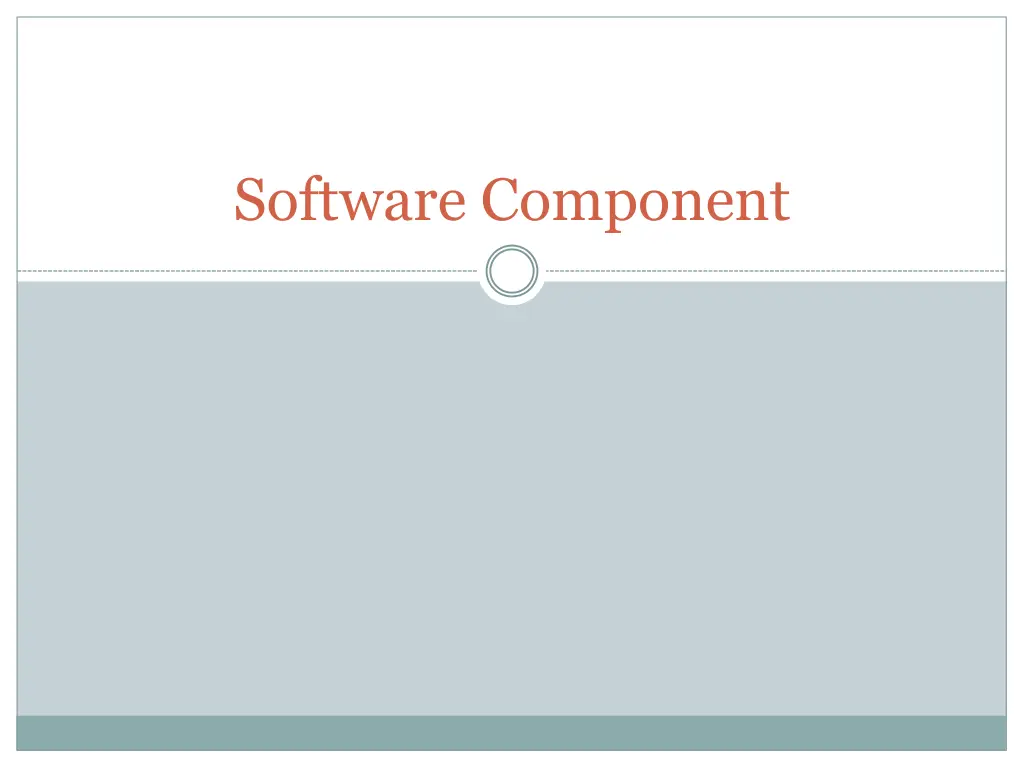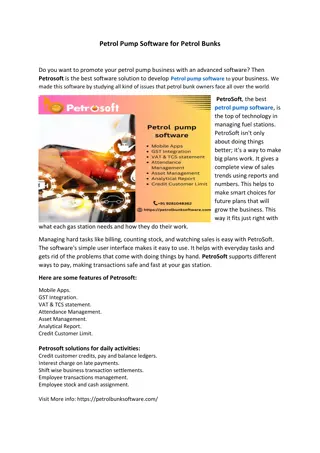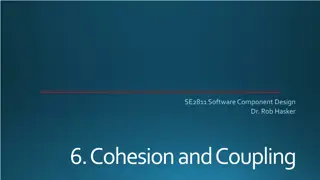
Understanding Software Component and Diagram Notations
Explore the concept of software components and component diagrams, which represent reusable software pieces, with structured classifiers shown through composite structures using parts, ports, and connectors. Learn how components collaborate to provide system functionality and how libraries play a vital role in software development.
Uploaded on | 2 Views
Download Presentation

Please find below an Image/Link to download the presentation.
The content on the website is provided AS IS for your information and personal use only. It may not be sold, licensed, or shared on other websites without obtaining consent from the author. If you encounter any issues during the download, it is possible that the publisher has removed the file from their server.
You are allowed to download the files provided on this website for personal or commercial use, subject to the condition that they are used lawfully. All files are the property of their respective owners.
The content on the website is provided AS IS for your information and personal use only. It may not be sold, licensed, or shared on other websites without obtaining consent from the author.
E N D
Presentation Transcript
Examples spreadsheet that can be dropped into any office productivity suite and an income tax object that can be dropped into any home tax package. A software component is really just an object that obeys sensible rules about its style of interface (as in using naming conventions to identify getters and setters). of software components include a
Component Diagram A component represents a reusable piece of software that provides some meaningful aggregate of functionality. At the lowest level, a component is a cluster of classes that are themselves cohesive but are loosely coupled relative to other clusters. Each class in the system must live in a single component or at the top level of the system. A component may also contain other components. Components are a type of structured classifier whose collaborations and internal structure can be shown on a component diagram. A component, collaborating with other components through well-defined interfaces to provide a system s functionality, may itself be comprised of components that collaborate to provide its own functionality. Thus, components may be used to hierarchically decompose a system and represent its logical architecture.
The Component Notation Since a component is a structured classifier, its detailed assembly can be shown with a composite structure using parts, ports, and connectors. For example : EnvironmentalControlSystem in this case, is included within the classifier rectangle in bold lettering, using the specific naming convention defined by the development team. In addition, one or both of the component tags should be included: the keyword label component and the component icon shown in the upper right-hand corner of the classifier rectangle Components may also have hidden ports, which are denoted by the same small squares, but they are represented totally inside the boundary of the composite structure, with only one edge touching its internal boundary. Hidden ports may be used for capabilities such as test points that are not to be publicly available. Ports are used by the component for its interactions with its environment, and they provide encapsulation to the structured classifier.
Function libraries: Related, high quality functions can be grouped into a library, so that they re available all at once. An example would be the stdio function library, originating on Unix systems, that provides input/output facilities for C programmers. Function libraries are used in both traditional systems development and object- oriented development. Well-designed libraries sometimes become standardized by bodies such as ISO or ANSI. Function libraries may be internal to a company, free, or sold for profit. Class libraries: An improvement on function libraries, class libraries offer whole classes rather than mere functions. Writing a class library requires lots of experience. Just like function libraries, class libraries may be internal to a company, free, or sold for profit.
Design patterns: A design pattern is a description of how to create part of an object-oriented system elegantly and effectively. Since their introduction, patterns have also been applied to other areas such as system architectures. description, a detailed description, advice on where to use it, and code samples. For example, the description of the Adapter pattern is An adapter translates the interface of one object into another interface that clients expect . Designing patterns requires a lot of experience, but less than producing a class library. Frameworks: A framework, as its name suggests, is a pre-existing structure to which you attach your own code. In the object- oriented case, a framework consists of a number of prewritten classes, along with a document describing the construction rules that must be followed by the developer. A large example is the Enterprise Java Beans (EJB) framework [Bodoff et al. 02]: this consists of the J2EE library plus a document, hundreds of pages long, that specifies how programmers should write reusable enterprise components and how third parties should implement Java application servers. Each pattern has a short
How should you design for reuse Always recommendations for how you should write your classes. If you write your classes in an exotic or personal style, potential reusers of your software will quickly move on to look at other code, rather than learn your personal idiosyncrasies. Style guidelines may originate from your company, or they be more widely accepted. For example, since Sun has control over the Java standard, whatever Sun says is good style is normally accepted by the Java community. As well as having a plethora of object-orientation gurus and experts of its own, Sun pays close attention to the opinions of external experts and gurus. Be prepared to write more code than you need: Often, when you re implementing a class for a particular system, you will find yourself thinking along the lines of I bet a foo method would come in handy here . For example, even if you currently only need a getRadius message for your Circle class, it would be a good idea to add a getDiameter message too, making the class more useful in other systems. follow style guidelines: Style guidelines are
Be thorough with your documentation: Few programmers will be able to understand how your classes should be reused just by reading the source code. At the very least, your class should have an explanatory name, a short comment (one or two sentences) summing up the class, a longer comment (maybe several paragraphs) describing how the class should be used and a short comment alongside each public message describing how the method should be used. Your comments should always describe the contract between the object and its clients, setting out the obligations on both sides. Documentation that is separate from the classes, such as design or tutorial information, should also be provided. Use patterns and frameworks: Patterns and frameworks reduce your workload, but they re also understood by other developers, which means that the other developers will have less to learn before reusing your code.
Design clientsupplier objects: If you have two-way, or even cyclical, collaborations between your objects, you may end up with what is referred to in the trade as code spaghetti. Things will be a lot simpler if you design your objects as a client supplier hierarchy. For example, a reusable Employee does not make any assumptions about its context; instead, it provides public messages that are generally useful. Taking this idea further, the Employee would be in control of its EmploymentHistory, but the EmploymentHistory would not know about the Employee. Imagine that your objects are servants that do what they re told, without caring about who asked them to do it. To compensate for their servile lives, the objects have servants of their own to control. Make each object single-purpose: This is referred to as high cohesion. Avoid coding objects that serve multiple purposes, such as maintaining an employee s personal information as well as their employment history.
Separate the interface from the business behavior: A reusable object should be usable in any context. For example, the object might need to be used, directly or indirectly, in many different kinds of interface (workstation, mobile phone, or Web server). If you pollute the object with the details of a particular interface, you will run into problems. Therefore, write business objects that contain only business behavior. You can also provide interface objects to view your business objects, but that s optional. Such interface objects will become reusable in their own right. Design for questions and commands: Objects are simpler if their messages are either questions What s the time? or commands Set the time to ... Although messages that are questions and commands at the same time are occasionally useful, you should consider their use to be an advanced technique. Combined messages, such as Set the time to ... and tell me what the time was before I set it , can be confusing.
Because object orientation is driven by the modeling of general concepts from an entire domain, it s much more likely that reuse opportunities will emerge. For example, developing a payroll system would normally involve the development of an Employee class. Since the development should be driven by What does the employee concept mean to this company? rather than What employee information does the payroll system need? , the end result is likely to be applicable to other systems developed by the same company. In addition, the modularity of objects reduces the tendency to spread attributes and operations around the system, making it easier to extract and refine the Employee code. Gradually, the situation has improved, to the extent that, often, we will only need to write the parts of the system that are unique to our problem the rest of the system can be implemented using prewritten code. This is especially true for common, well understood, application areas such as: user interfaces; database access; distributed programming; input/output; network access; e-commerce; access to legacy (pre-existing) systems; security (authentication, authorization, privacy, integrity checking, origin checking); text processing; mathematics; games; service look-up; sound synthesis and playback; 2D graphics; 3D graphics; e-mail; image processing; multimedia messaging; transaction processing; telephony; speech synthesis and recognition; and integration with digital TV broadcasts. encoding and decoding;
Categories reuse opportunities Reusing functions within a system: The simplest form of reuse (used in traditional systems development) involves writing utility functions that are called from various places. For example, you may discover that various parts of your system need to search through a list of customer names, so you write a general search function that can be called from each context. Writing reusable functions is different from writing functions that break a complex process into simpler steps. Reusing methods within an object: Methods encapsulated within an object can be invoked from other methods. drawFilledRectangle method inside a GUIComponent class can be used by any GUIComponent method that needs to fill an area of the screen with the current background color. You should aim to reuse methods within an object whenever possible. Nonpublic methods within an object are often used to break up a complicated process, in traditional fashion. For example, a nonpublic
Reusing classes within a system: Many of the classes that we define can be used in different parts of our system. For example, if you define a Customer class for use in a marketing system, you expect the same Customer object to appear in many different pieces of system code. This kind of reuse is fundamental to the object-oriented approach. Reusing functions across systems: General functions can be reused (in traditional systems development as well as in object-oriented development) in other systems that you and your colleagues produce. For example, you might write a function that extracts the year that an employee joined the company from the employee s payroll number. For such a function to be reused by your colleagues, you would have to make them aware of it, preferably by putting it in a reuse repository: a database of useful functions that developers are expected to peruse when they re writing new code.
Reusing classes across systems: We can publish and reuse a whole class (with all its attributes and operations) rather than just a single function. An example would be an Employee object that encapsulates the employee attributes used throughout the company, along with a useful set of operations. Object-orientation enthusiasts were the ones who popularized the idea of a reuse repository containing classes rather than functions. Reusing classes across all systems: A software component is analogous to a hardware component. Software components are designed to be reusable in any context; are strongly encapsulated (clients can t see the inner workings); come with a standard style of interface; and are available from third parties, usually in return for payment. Every object- oriented programming language component, for example, Java has JavaBeans. There is no real equivalent of software components in the traditional arena, because a handful of related functions would not be of much use to third parties. has its own form of software






















